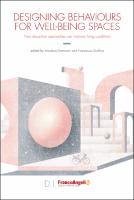Designing Behaviours For Well-Being Spaces
How disruptive approaches can improve living conditions
| dc.contributor.editor | Dominoni, Annalisa | |
| dc.contributor.editor | Scullica, Francesco | |
| dc.date.accessioned | 2022-03-28T15:31:49Z | |
| dc.date.available | 2022-03-28T15:31:49Z | |
| dc.date.issued | 2022 | |
| dc.identifier | ONIX_20220328_9788835133636_10 | |
| dc.identifier | OCN: 1313548391 | |
| dc.identifier.uri | https://library.oapen.org/handle/20.500.12657/53629 | |
| dc.description.abstract | Spaces and their views are changing. The perception of physical and mental well-being is also shifting, especially because of the pandemic. We are experiencing a transitional time where new needs and requirements emerge, affecting human behaviour and the space definition at macro and micro level. New dynamics and perceptions are recognized, leading architects and designers to focus on studying and applying innovative methods. The book explores the radical transformation of living and working spaces, in which the hybridization of interior and exterior requires a new vision able to interpreter renewed people’s behaviours and needs, a challenging issue for the design discipline that has a multidisciplinary nature as well as a multiscale approach for both research and practice. Many examples today demonstrate the importance of the therapeutic contribution of architecture and design, to redevelop places of hospitality and care, and create environments in which there is a deep harmony of space, light, and beauty. The interest in research concerning the quality of life has also increased a lot of studies on the complex question of the environmental perception and the importance of natural stimuli for health in interiors, in which the physiological effects of light and colour are fundamental to balance the of human beings’ equilibrium. In the book we present testimonies of international researchers and designers who propose disruptive scenarios and methodologies to improve wellbeing and mental health conditions overall life quality at urban and personal living level through several examples: the city and the relations with the environment, commercial and hospitality areas, personal spaces, as well as outer space, in microgravity and confined environment, where the astronauts’ experience living in confined environments can be compared to the domestic space and office interiors. Our ambition is to re-launch an aesthetic, sustainable, design-based approach to improve dwelling conditions, trying to implement care into different well-being dimensions – mental, physical, social, and global – looking at the new people’s behaviours, or even, generating new behaviours, through design. | |
| dc.language | English | |
| dc.relation.ispartofseries | Design International | |
| dc.subject.classification | thema EDItEUR::W Lifestyle, Hobbies and Leisure::WJ Lifestyle and personal style guides::WJK Interior design, decor and style guides | en_US |
| dc.subject.classification | thema EDItEUR::A The Arts::AM Architecture::AMC Architectural structure and design::AMCR Environmentally-friendly (‘green’) architecture and design | en_US |
| dc.subject.other | Interior design, well-being care, hybridization, environment | |
| dc.title | Designing Behaviours For Well-Being Spaces | |
| dc.title.alternative | How disruptive approaches can improve living conditions | |
| dc.type | book | |
| oapen.relation.isPublishedBy | e2ddfb5e-9202-4851-8afe-1e09b020b018 | |
| oapen.relation.isbn | 9788835133636 | |
| oapen.pages | 142 | |
| oapen.place.publication | Milan |

